#serial experiments lain homage
Explore tagged Tumblr posts
Text
also Lady had a 2th project (or a sequel anime) for the 15th anniversary of the anime series as one of three anime OVAs/animes created, and it was based off of Momona’s rival/sister-in-law, Lillian and titled: Lillian.exe, and was a homage to the 1998 anime, Serial Experiments Lain, just like with the Sunshine OVA and the other Lady OVA which also aired on TV, Lillian.exe aired on TV as well, unlike the other two which aired at 11:00/11:30, Lillian.exe aired at late-at-night, but at different times and dates on different channels, the main ones, it aired on were Jewelpet’s normal broadcast homes, TV Tokyo and TV Osaka, unlike the Sunshine and the other Lady OVA, which aired on TV as cross-promotion, Lillian.exe aired on solely on TV, but appeared later on home video.
This was also the only Jewelpet type of media or type of animation from a season’s universe to not feature an appearance of Ruby and her human partner, Lady’s human partner for Ruby being Momona instead, it focused on Lillian, this also did feature Luea, but she was only mentioned or an cameo, or speaking off-screen until the final episode where she made a full appearance, though not appearing, there were mentions of Ruby and Momona, and also cameos of characters from Lady and other shows in a non-canon sense. Here’s the recreated poster I made from the dream of the actual poster i saw in that dream. Genres: Cyberpunk, Psychological Horror, Techno Horror, Science Horror, Neon. TV Networks: TV Tokyo, TV Osaka, TV Aichi, Family Gekijo, Star Channel. Opening:「DUVET」 by Jasmine Rogers and Bôa, song lyrics by Jasmine Rogers, Airdate: October 23th 2025 - September 2th 2026 (TV Tokyo), Lillian - Voice Actress: Risa Taneda, Animation Studios: Studio DEEN, Studio Ghibil/ZEXCS (additional help), Sponsors/Creators: Sega Fave, Sanrio, Bandai, Bushiroad, Yume Creations. Licensing: TMS Entertainment

#jewelpet lillian#lady jewelpet#horror#psychological horror#techno horror#cyberpunk#anniversary project#romance#serial experiments lain#homage#serial experiments lain homage#jewelpethorror#lillianexe
3 notes
·
View notes
Text
Invader Zim gives me that Serial Experiments Lain, Courage The Cowardly Dog, and Tim Burton vibes when I first watched it.
While watching Death note, in the opening, there's that one scene where Light is colored in red, while L is colored in blue reminds me of that scene in "Rise of the Zit Boy" (a very weird Invader Zim episode.) Where Zim tried to hypnotize Dib using Pastulio, and Dib tries to close his eyes to resist that and Zim is colored in red, while Dib is colored in blue.
#invader zim#serial experiments lain#courage the cowardly dog#tim burton#death note#That death note scene is probably a homage or an inspiration they get from Invader Zim.
11 notes
·
View notes
Text
ESSAY: Stranger in a Stranger Land — How Chiaki J. Konaka Made Aughties Anime Terrifying
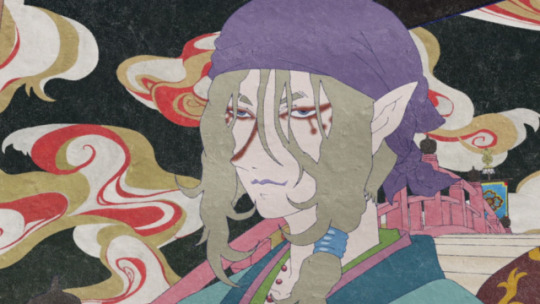
If you were watching anime in the early 2000s, you know who Chiaki J. Konaka is. If you didn’t know him by name, you were probably familiar with his work on cult classics like Serial Experiments Lain or Digimon Tamers. With other influential series like Texhnolyze, Air Gear, and Mononoke under his belt, Konaka’s work has no doubt become some of the major hallmarks of anime available to English-speaking audiences in the early aughts.
That being said, Konaka’s work has a reputation for pushing boundaries against the convention of genre. An avid fan of horror, Konaka’s career began in live-action home video movies and television, where he explored topics such as the supernatural, extraterrestrials, and cults. By the time Konaka began working on anime, he already had made a name for himself appealing to a broad demographic. Having written everything from episodes for the popular Gakkou Kaiden (Ghost Stories) live-action television series to niche monster movies, he demonstrated a sharp eye for conventions of each particular genre and more importantly, why they worked so well. One thing has remained consistent throughout Konaka's career: his commitment to a uniquely private brand of horror.
Girl, Interrupted
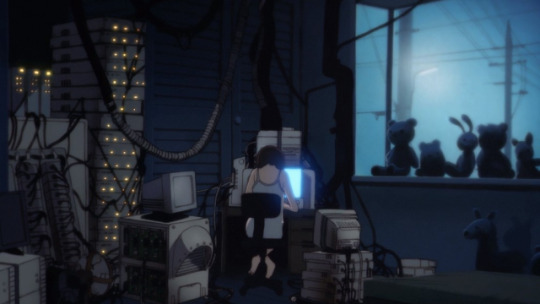
Lain in her room (Source: Funimation)
One of Konaka’s most prevalent themes is being a stranger in a strange land. Whether for the sake of narrative convenience or simplicity, many of Konaka’s protagonists — regardless of the material's genre — often find themselves in bizarre down-the-rabbit-hole scenarios. The most famous example of this is, of course, Serial Experiments Lain, a cyberpunk series about a deeply isolated girl who discovers an internet world called “The Wired.” Following the later-end of a cyberpunk boom in Japan with directors such as Shinya Tsukamoto and Mamoru Oshii accumulating international cult-followings, the verge of the new millennia couldn’t have been a better time for Konaka’s most iconic work to debut.
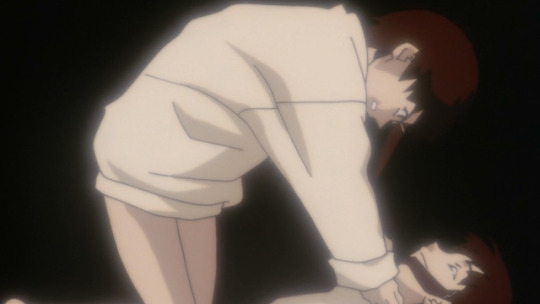
Lain confronts the fake Lain inside The Wired (Source: Funimation)
In an entry on his personal blog, Konaka writes that Lain was initially planned as an interface-heavy game for the PlayStation, which didn’t offer him many scenario writing opportunities. It was decided a 1998 late-night anime would be produced to promote the game, which would offer Konaka ample space to explore Lain’s world with fewer constraints. This approach to scriptwriting led to Lain’s infamously ambiguous story structure, which centered on Lain gaining access to The Wired and the various anonymous organizations vying for power within it. Unlike the PlayStation game, which relied heavily on players navigating a complex system of computer files about Lain, Konaka’s anime adaptation provides an intimate over-the-shoulder perspective. Lain, an introverted young girl, is quick to embrace a myriad of “other” Lain personae online. In episode 8 "Rumors," Lain returns to her own reality after confronting and attempting to kill one of the fake Lains in The Wired — only to find yet another "fake" Lain has somehow planted herself among her friend group. Whether it's a hallucination or not, it's a jarring moment of emotional whiplash and confirms Lain's fears aren't just online, but that her anxieties over her identity are becoming very real.
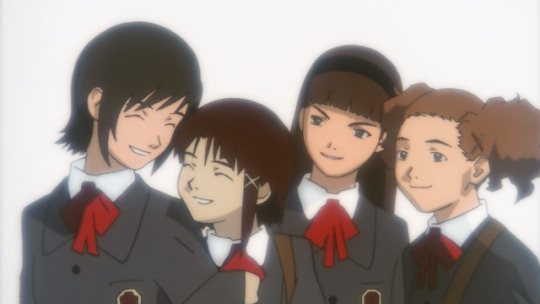
A "fake" Lain from The Wired among her real-world school friends (Source: Funimation)
For Lain, it becomes increasingly difficult to determine whether or not people like her or the internet's perverted image of her. The uncanniness Lain experiences isn’t a fear or helplessness to an almighty force or evil corporation like other cyberpunk stories. Rather, Lain’s biggest fears are these alarming encounters with her split virtual personalities — a stark reminder of who she may become after the inevitable collision between The Wired and reality. In the end, she is her own worst fear.
The Lovecraftian Connection
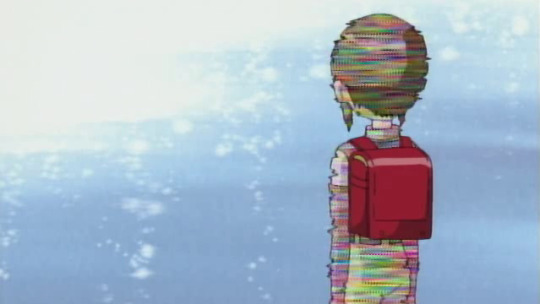
Gatomon watches Kairi "glitch" as she wanders across the street in a daze (Source: Hulu)
Although Konaka has certainly gained a reputation for his work flirting with cyberpunk, it’s by far no means the only format capable of unpacking these complicated themes of self-realization. Like many fascinated by the weird, Konaka is famously fixated on the works of American horror writer H.P. Lovecraft. It could even be argued Konaka is just a horror writer flirting with hybrid supernatural science-fiction. Much like the genre-omnivore his early writing credits would imply him to be, the way Konaka has approached a score of fantasy and cosmic-horror lend themselves to a far more liberal application of Lovecraftian tropes. This, of course, has given us some of the most unlikely mash-ups of thematic material, such as his episode “The Call of Dragomon” in Digimon Adventure's follow-up, Digimon Adventure 02.
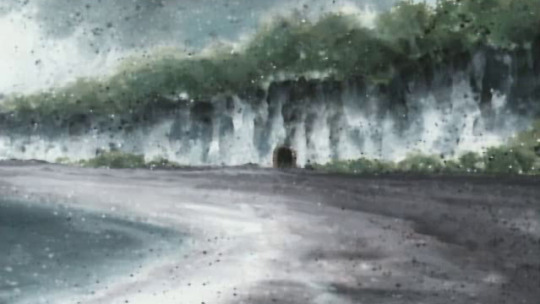
The cave beside the mysterious Dark Ocean (Source: Hulu)
Obviously, a reference to Lovecraft’s 1926 short story “The Call of Cthulhu,” this episode was initially conceived as the starting point for an eventually abandoned story arc about the mysterious Dragomon entity. As if this didn’t make the episode interesting enough, it’s significantly darker in tone compared to the series’ typical upbeat mood. Kairi, an otherwise confident and outspoken girl, suddenly develops strange dreams and Lain-reminiscent behavior. Kairi eventually begins to develop hallucinations about being underwater and being watched. Eventually, she finds herself staring out at an ocean and exploring a dark cave — somewhere neither in the Digital World nor the real world. This is when things get uncomfortable — even in a reality where traveling between cyberspace and the real world is possible, there are still unknowable “in-betweens” yet to discover. Again, the slow unraveling of horror isn’t the reveal of Dragomon, but rather Kairi’s atmospheric aloneness in realizing the reality she’s taken for granted can suddenly be uprooted without warning. Classic existentialist cognitive dissonance. But, y'know. For the kids.
No One Can Hear You Scream in Cyberspace
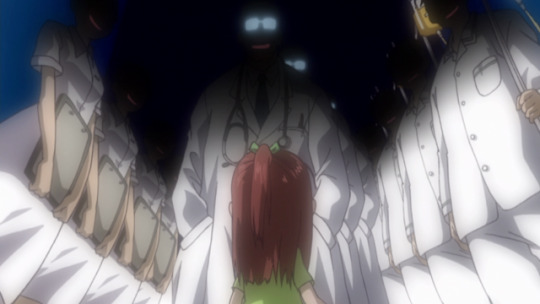
Jeri is psychologically tormented by the D-Reapers and relives her mother's death in the hospital (Source: Hulu)
After Digimon Adventure 02, Konaka would continue exploring this theme of protagonists inadvertently entering “new worlds” and having to reconcile their identities as a consequence. Like Lovecraft’s characters uprooted by the mere knowledge of cosmic horrors in isolation, Konaka’s characters must sink or swim when it comes to reality-shattering revelations. Konaka’s writing on 2001’s Digimon Tamers strongly flirts with these ideas, going beyond a simple “deconstruction” of the series’ basic premises toward a more psychological direction. Although Tamers' main protagonist Takato is himself an idealistic fan of an in-universe Digimon franchise, Tamers doesn’t forego the very real consequences of abruptly being spirited away to a violent new world. The kids aren't simply away at summer camp anymore — after a few dozen encounters with god-like creatures, the mental strain begins to slowly creep up on the DigiDestined. Rather than escaping without consequences, Konaka’s DigiDestined have to face the music and realize their escapist fantasies about Digimon aren’t what they imagined. This version of the Digital World isn’t morally flat, but something borderline Eldritch that becomes fully realized in the series finale.
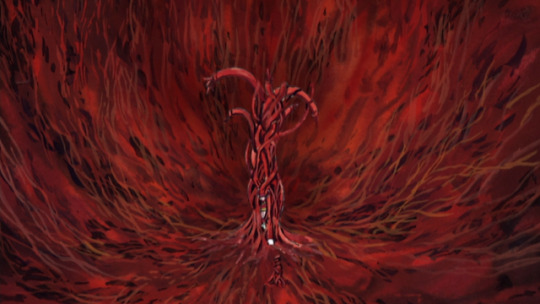
Jeri captured by the D-Reapers with Calumon (Source: Hulu)
In Tamers' climatic arc, Jeri, Takato’s eccentric classmate and fellow Digidestined, is abducted by man-made programs called “D-Reapers” as they take over the city. The D-Reapers, who intend to eliminate both the human and Digimon world, attempt to transform Jeri into the “Mother D-Reaper” by channeling the traumatic memories of her mother’s death. As notorious as Tamers' ending has become, it's perhaps not as brutal in the broader context of Konaka’s work. While captured, the D-Reapers keep Jeri in a Nyarlathotep-like cyber-flesh tower — similar to Tsukamoto’s half-man, half-machine character from Tetsuo: The Iron Man. Jeri doesn't have the intermediary of a Digimon to help — her partner Leomon is gone — and therefore has to face the unintelligible cosmic-cyberpunk D-Reapers alone. The “real” Jeri is momentarily gone. Like Lain’s lost identities in The Wired. Again, an adolescent protagonist must face the horror of losing one's self in a world with no logic. For a moment, she becomes truly hopeless, believing that this is "fate," recalling the phrasing doctors used described her mother's death. Thankfully, Jeri recovers and reunites with her friends as the equilibrium between the Digital World and reality are stabilized. But the point still stands: Our most intimate fears far surpass anything else we can face in the most alienating of scenarios.
The Petty Exorcist
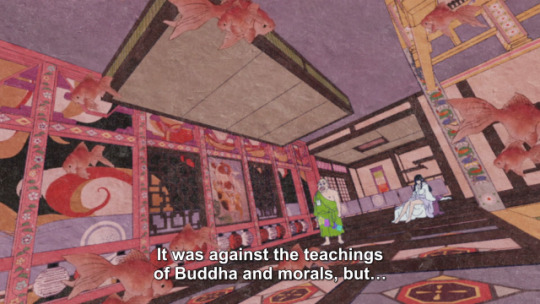
Genkei confides to The Medicine Seller aboard the ship
Beyond flights of cyberpunk cognitive dissonance fancy, Konaka’s work on the 2007 series Mononoke draws a more direct line back to his origins in Japanese horror cinema. A spin-off of the Ayakashi: Samurai Horror Tales series, Mononoke focuses on a pointy-eared man known as the “Medicine Seller” and his mission to terminate malicious spirits called “mononoke” across feudal Japan. Konaka’s story-arc “Sea Bishop” pays homage to classic funayūrei (boat spirit) ghost stories with a whodunit twist after someone sabotages the ship's navigation. Having wandered into the Dragon Triangle, a dangerous part of the Pacific Ocean full of evil spirits, a monk aboard named Genkei is suspected of the deed. Rather than immediately deal with any suspected mononoke, the Medicine Seller must decipher the true reason Genkei led them astray — his challenge isn’t an exorcism, but rather distinguishing petty human lies from truths. Genkei explains he did so to free his sister's spirit, who was supposedly sent to sea in his stead as a human sacrifice. Up to this point, Genkei’s intentions seem noble until his manipulative past is revealed: He had been fighting incestuous thoughts and guilt for years, having only become a monk to cope with his feelings. His sister died in vain.
The True Face of Horror Is Your Own
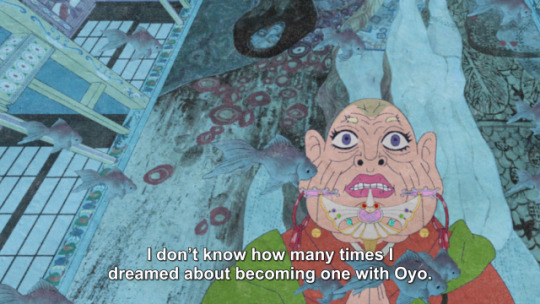
After the Medicine Seller reveals he knows someone is lying on the ship, Genkei gives his confession
Satisfied with Genkei's understanding he has been living a lie, the ship's mononoke finally emerges to be slain. It’s only this expulsion of a private fear that allows the Medicine Seller to finish his work. This time, no one is being manipulated by spirits or supernatural entities — all that remains is one person's terrifying inability to see beyond the lies they forced themselves to believe. The "real" you is worse than anything you can imagine.
Konaka’s fiction rarely gives us easy answers. While his work may seem oblique and impenetrable at first, these are fundamentally stories about people’s biggest fears being themselves and what they believe they know to be true. Although the novelty of being whisked to a fantastical world is alluring, Konaka doesn't downplay the expected alienation and anxieties of his characters. For as wide-ranging and genre-agnostic as his many series are, they never lose track of what fundamentally makes this flavor of horror unique: an embrace of the uncanny, the bizarre, and unflinching honesty.
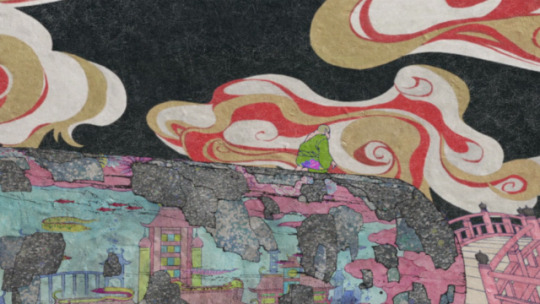
What spooky anime gives you nightmares? Let us know in the comments!

Blake P. is a weekly columnist for Crunchyroll Features. Impmon did nothing wrong. His twitter is @_dispossessed. His bylines include Fanbyte, VRV, Unwinnable, and more.
Do you love writing? Do you love anime? If you have an idea for a features story, pitch it to Crunchyroll Features!
19 notes
·
View notes
Text
Adventure’s Lain Homage
We all know head writer for Serial Experiments Lain Chiaki Konaka also wrote Digimon Tamers and episode 13 of Zero Two. No surprise that Tamers is full of Lain references and parallels, but don’t think season one didn’t start the party early!
Most Lain episodes start with the same familiar sequence of city shots. Episode 33 of Digimon Adventure, the Shibuya episode, starts out following this sequence shot-by-shot:






I took the screencaps for these a year ago meaning to do this post and never got around to it. Thankfully they came in handy when Kakudou mentioned the homage on Twitter a couple weeks ago and I could offer photographic evidence. Konaka even replied to supply the equivalent shots from Lain!
Want to support my site and/or my work? Buy me a coffee!
97 notes
·
View notes
Text
you know, one of the greatest Digimon mysteries to me is who exactly Digimon Tamers was for and how it got made.
I mean, it’s way darker, slower, and more psychological than any other kid show I can think of, but it’s too, you know, digimon, to be for grown ups. At the end of the day after all it is about cute kids and their cute monster friends.
But the writer is like this hardcore Lovecraft fanboy and yeah he’d written for digimon before, but he also did the whole Dark Ocean thing which was really weird? He apparently decided it was appropriate to use a children’s show to homage a horror story that was about fish people having sex with human women and making spooky half-breed babies because Lovecraft, brilliant as he was, was a huge racist at the time and didn’t like the idea of mixing the races. I mean there’s nothing wrong with referencing it, and I don’t think Konaka is a bigot from what little I know of him, it’s just... maybe digimon isn’t the place?
So, Toei looked at that and his Cthulhu Mythos work and Serial Experiments Lain and decided YES THIS IS THE MAN TO WRITE OUR NEXT CHILDREN’S TELEVISION SERIES and then he wrote digimon and it was more or less exactly what you would expect from a man who worked on all of those things.
Tamers is one of my favorite shows ever, I just. Don’t understand. What even the fuck. As a child, it was absolutely horrifying to me. Megidramon was the scariest thing I’d ever seen, at least until the D-Reaper took center stage at which point it was just horror-terror after horror-terror constantly one-upping each other.
24 notes
·
View notes
Text
Cube Escape/Rusty Lake
Jadi awalnya gara-gara Pritha ngetag gw di instagram Pandora Experience yang fotonya memperkenalkan skenario room baru mereka yaitu Temple of Osiris. Mulai lah gw jadi tertarik sama yang namanya escape room ini. Emang sih gw telat banget jump ke bandwagonnya, tapi itu emang udah kebiasaan gw hahah. Oleh karena ngebet banget ngebayangin main seru-seruan sama para sahabat terdekat, gw jadi mencari game bergenre serupa di Playstore. Top result yang muncul membuat gw kecewa. Gw ga suka sama tampilan dan gameplay Escape Game. Lalu ada lagi yang merekomendasi 100 Doors Challenge, beuuh apa lagi itu cuma nemu pintu doang. Grafis yang 3D juga ga bikin gw nafsu.
Lalu gw nemu lah Cube Escape; Arles, gw tertarik banget pingin nyoba karena, tak lain dan tak bukan, Vincent. So that’s when I started this fandom journey. Gw akan review per game, sesuai urutan gw mainnya.
1. Cube Escape; Arles: gw sukaaaaa sama artworknya yang pay homage to Vincent. Settingnya juga kamar dia di Arles, ada beberapa karya Vincent yang muncul, sampe Paul Gauguin juga ikutan nongol haha. Gameplaynya sederhana yakni point and click dan player disuruh memecahkan puzzle yang ada untuk ‘escape’ the room. Episodenya terhitung cukup pendek dibanding episode lainnya, cuma props buat artstylenya yang udah bikin gw langsung jatuh cinta. Tak lupa juga storyline dan elemen cerita lainnya yang creepy plus surreal.
2. Cube Escape; Theatre: setelah Arles, gw langsung download semua Cube Escape (yang gratis). Gw milih ini untuk dimainkan pertama karena terpikat sama judulnya aja (agak random emang). Kesannya saat main, emang beda tone sama setting Arles yang lebih hidup warnanya, cuma atmosfir dari Theatre, terutama tokoh yang muncul dan red curtainnya, ngingetin gw sama karya David Lynch banget, terutama Eraserhead dan Twin Peaks. And later that I know, Rusty Lake, studio yang bikin game ini berkantor di Amsterdam! Ditambah lagi latar belakang mereka membuat game ini yakni emang keinspirasi Twin Peaks, harapannya mereka bisa jadi the Twin Peaks of gaming. Gw sangat lah terpukau! Lalu setelah liat situsnya juga gw baru tau bahwa Cube Escape ini ceritanya nyambung satu sama lain, jadi mulai lah gw memainkan game dengan urutan sesuai jadwal rilis mereka.
3. Cube Escape; Seasons: installment pertama dari serial menakjubkan ini. Menurut gw Seasons termasuk salah satu game top mereka karena durasi alur cerita dan kemampuan pemain untuk ‘berjalan-jalan’ melewati waktu. Oleh karena dia merupakan episode pertama, jadi banyak elemen ceritanya yang merupakan fondasi penting dari Rusty Lake saga keseluruhan. Trus atmosfir game ini (sorry, serial ini) emang segalanya ya. Gw suka pemakaian musiknya, terutama kalo udah melibatkan Gymnopedie karyanya Erik Satie, wah langsung auto melankolik gw. Hal yang bikin gw ekstatik lagi yaitu dipakainya backward speech ala Twin Peaks di telepon! AAAAAAK langsung keinget sama the Man from Another Place kan gw :D
4. Cube Escape; The Lake: termasuk episode yang pendek, tapi memperkenalkan lebih jauh mengenai danau tempat Rusty Lake berada dan tokoh antagonisnya (siapa sangka ternyata doi kepancingnya sama udang?)
5. Cube Escape; Harvey’s Box: episode pendek juga dan gw rasa cukup menarik karena mengambil perspektif dari Harvey, burung parkit yang hampir selalu nongol di tiap episode Cube Escape. Maka dari itu, episode ini gw rasa bisa digolongkan sebagai spin off, ga terlalu banyak yang ia sumbang ke narasi besar Rusty Lake.
6. Cube Escape; Case 23: episode yang panjang dan paling bikin frustrasi kalo kata gw hahahah. Pemain berperan sebagai detektif Dale Vandermeer (Dale Cooper, anyone?) yang menyelidiki kematian perempuan di Seasons, yaitu Laura Vanderboom (again, Laura Palmer?? haha). Pembagian per chapternya sangat bagus, puzzlenya beragam tapi di sisi lain, ada yang susah karena gw benci 3x3 sliding puzzle. Lalu ada juga yang mengharuskan gw buat bolak-balik ganti kertas OHP, tapi gw tetep aja ga bisa nemu akibat gambar yang jelek. Logikanya sih paham. Chapter terakhir di episode ini mungkin yang paling menegangkan karena satu-satunya yang ada timernya. Bener-bener horor dan menegangkan deh.
7. Cube Escape; The Mill: durasi episodenya sedang dan menurut gw ini episode paling Belanda banget haha, tentu karena windmolennya. Episode ini juga ngambil perspektif salah satu penghuni Rusty Lake yang udah ‘berubah’ jadi menurut gw cukup unik. Hanya saja menurut gw puzzlenya di sini agak repetitif dan murahan.
8. Cube Escape; Birthday: di episode ini, pemain dibawa ke memori ulang tahun dari Dale Vandermeer dan dark banget! Menurut gw episode ini panjangnya pas dan cukup bagus dari segi cerita. Menegangkannya dapet (gw benci bayangan di jendela!) dan happy endingnya juga dapet. Trus pake adegan klimaks badass pula! Meski demikian, episode ini gw rasa berkesan kayak spin off gitu sih.
9. Cube Escape; The Cave: ini adalah episode gratis terakhir yang ada di peredaran saat post ini ditulis. Durasi episodenya bisa disamakan dengan Case 23 dan puzzlenya beragam (dan gw bangga bisa mecahin sendiri beberapa), tapi ada juga sedikit yang murahan *agak ga jelas maksudnya apa* dan repetitif. Namun kekurangan tersebut ditutupi oleh narasi episode ini yang menurut gw memberikan banyak informasi mengenai semua tokoh yang pernah muncul selama 8 episode sebelumnya. Sayangnya, ada beberapa halaman di buku yang akhirnya ga dijelaskan. Gw pikir itu puzzle, ternyata bukan. Apa gw yang kelewat maksudnya karena bodoh? Trus buat pertama kalinya di game ini ada fitur hint. sebel sih gw, jadi terlalu gampang gamenya.
10. Samsara Room: secara narasi memang ga ada hubungannya sama semua game di atas. Namun Samsara Room ialah game pertama yang dibuat oleh Studio Rusty Lake dan banyak elemennya yang dibawa ke Cube Escape; Seasons. Gw rasa buat storylinenya cukup bagus karena sesuai dengan judulnya, Samsara, ‘makhluk’ yang kita kendalikan beda-beda. Gw suka banget pas perspektif kameranya juga ikutan menyesuaikan haha. Lalu kalo dipikirkan lagi, endingnya filosofis ga sih? Lalu kenapa kita kembali ke telor? Selama permainan juga kita reinkarnasinya malah ke sesuatu yang lebih buruk gitu dah, apa dosa kita selalu besar banget?
Demikian lah review singkat gw akan semua episode gratis dari Rusty Lake saga ini. Sebenarnya ada episode premium yang berjudul Rusty Lake; Hotel, Roots, dan Paradise yang kalo liat sinopsisnya, lebih ke genre point and click ketimbang escape the room. Namun kayaknya ketiga game tersebut memberikan kisah latar belakang yang sangat kaya akan Rusty Lake. Gw jadi penasaran! Namun ga bisa main karena ga ngerti cara beli google pay :(
Trus di situs mereka juga sebentar lagi akan rilis episode kombo short film/game berjudul Paradox. Gw liat trailer filmnya, beuuuh keren gilak! Beneran kayak game comes to life! Gw harap sih David melirik buat ngebikin feature lengthnya gitu hahaha #ngarep.
0 notes
Text
Also I realized that Lady had a 2th project (or a sequel anime) for the 15th anniversary of the anime series and it was based off of Momona’s rival/sister-in-law, Lillian and titled: Lillian.exe, and was a homage to the 1998 anime, Serial Experiments Lain, just like with the Sunshine OVA and the other Lady OVA which also aired on TV, Lillian.exe aired on TV as well, unlike the other two which aired at 11:00/11:30, Lillian.exe aired at late-at-night, but at different times and dates on different channels, the main ones, it aired on were Jewelpet’s normal broadcast homes, TV Tokyo and TV Osaka, unlike the Sunshine and the other Lady OVA, which aired on TV as cross-promotion, Lillian.exe aired on solely on TV, but appeared later on home video.
This was also the only Jewelpet type of media or type of animation from a season’s universe to not feature an appearance of Ruby and her human partner, Lady’s human partner for Ruby being Momona instead, it focused on Lillian, this also did feature Luea, but she was only mentioned or an cameo, or speaking off-screen until the final episode where she made a full appearance, though not appearing, there were mentions of Ruby and Momona, and also cameos of characters from Lady and other shows in a non-canon sense. Here’s the recreated poster I made from the dream of the actual poster i saw in that dream. Genres: Cyberpunk, Psychological Horror, Techno Horror, Science Horror, Neon. TV Networks: TV Tokyo, TV Osaka, TV Aichi, Family Gekijo, Star Channel. Opening: 「DUVET」 by Jasmine Rogers and Bôa, song lyrics by Jasmine Rogers, Airdate: October 23th 2025 - September 2th 2026 (TV Tokyo), Lillian - Voice Actress: Risa Taneda, Animation Studios: Studio Comet, Studio Ghibil/ZEXCS (additional help), Sponsors/Creators: Sega Fave, Sanrio.

Guys, I had a dream that Jewelpet Sunshine had an OVA, and the theme song for the OVA is 「BREAK THE CHAIN」 from Nami Tamaki, the song was originally from Battle Spirits: Garrett’s Revolution, but Studio Comet was allowed to use it under the permission of BN Pictures and Bandai, as then I went in Google, the new OVA series basically reused mature themes from Jewelpet Twinkle, like issues of parental abandonment and neglect as one of its most recurring themes. People have problems with their families. The villain was someone who's fated to die an early death due to her powers, and who's been forcefully separated from her family, along with Sunshine having incest, zoophilia as plotlines along with the final episodes have God becoming corrupt and nearly killing the entire earth. and for the Sunshine OVA, it explores deeper and expands into some of those themes like: issues of parental abandonment and neglect, problems with family members. The generals of the main antagonist, who are aliens are fated to die an early death due to their powers, and who's been forcefully separated from their families, after being brainwashed, and literally murdered, and then being brought back from the dead via torture to turn into mindless human slaves, including more mature themes in Jewelpet like: war, politics, racism, and more - so this is basically what went down in the show or the show’s storyline: Kanon is now 23 years old as it had been five years since the events of the final episode of Sunshine (Season 1): Graduation Ceremony! Yay!, Kanon is a tough-as-nails teacher and carries Teacher Iruka around with her, Iruka marries Jill, Garnet hits it big as an actress along with Masago as a director, Sapphie and Nejikawa are renowned astronauts, Shouko and Angela win the Moto GP, Hinata is a firefighter, Peridot is a famous ice-skater, Labra works for Jewelina and last but not least, Ruby finds Mikage, who is now Granite, again and they become lovers, in her class that she becomes in charge of, Kanon is both a bit traumatized and reminded of dead ringers of her own class from many years back, the reason why Kanon is so strict with her students, is because she doesn’t want them to end up the same way her class did many years ago, during one evening, a meteorite appears in the skies from outer space, a mysterious caped figure appears from the meteorite, which is actually a UFO - as NASA investigators wonder what the caped figure’s plans are, they end up being killed by him, the caped figure named Lord Darkness, has came from outer space along with his generals, the Orcs, who are human-turned alien slaves fated to die an early death due to their powers, and who's been forcefully separated from their families, after being brainwashed, and literally murdered, and then being brought back from the dead via torture to turn into mindless slaves, as they declare war on both the Earth and JewelLand, the students all notice the Orcs heading for Sunshine Academy, as then an evacuation is underway, as the academy gets destroyed - then Ruby, along with all of the Jewelpets, notice Lord Darkness arriving walking towards them, as then Kanon stops Lord Darkness, Lord Darkness fatally stabs her, as Ruby tries to hit Lord Darkness, but he injures her - forcing her into a coma, as then Kanon tries to get up, as Granite appears as he tries to helps Kanon, as Kanon realizes it’s her brother who is Granite, as she slaps him for falling in love with Ruby, calling him “sick and perverted” and for putting Ruby in a coma, then Ruby realizes that Lord Darkness’ plan is to receive the Primus Seed, a remarkable and enigmatic artifact with transformative properties. It is a multipurpose seed that holds immense power and potential. the Primus Seed is capable of altering physical forms, enhancing abilities, and connecting different universes within the multiverse, however without it: the universe can’t be connected, as JewelLand and the Earth are both under war, whatever side wins, they both lose, that’s some crazy stakes, even a children’s franchise like Jewelpet.

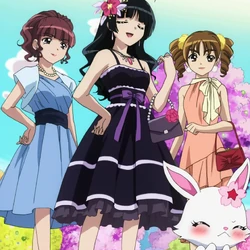
Kanon notices JewelLand along with the Earth getting destroyed, buildings are crumbling, people are dying, as the weeks pass by, more and more destruction happens, until one night, when a giant explosion hits London as then a massive casualty happens, in which 28484 people were killed, and there were 19295 people injured, and along with landmarks almost being destroyed, like the London Bridge and Big Ben, as then Kanon is horrified at the amount of events going on, as then Ruby awakens from her coma, as Ruby notices the terror around her, she is worried about Kanon and Granite, Ruby asks: What is going on? Kanon, where is Granite?, Kanon says in a angry tone: MY BROTHER, HE WANTED TO BE WITH YOU FOREVER, THAT’S DISGUSTING!, the Orcs are about to kill Kanon and Ruby until Kanon shouts: “I-, I-, I WANNA TO PROTECT RUBY!” as then Ruby turns into a young girl, who has fair skin and cherry red eyes. She has cherry red medium length hair and wears a thin fuchsia magenta pink headband with her signature cherry blossom flower ornament with a powder white large kerchief attached to it. She also wears a light pastel fuchsia magenta pink unbuttoned seifuku jacket with side pockets and a powder white shirt with a pastel fuchsia magenta pink folded collar. She wears a pleated pastel fuchsia magenta pink skirt, powder white long socks, and pastel fuchsia magenta pink shoes. Her shoelaces resemble Ruby's signature cherry necklace, as then Kanon is shocked at what happened - Kanon and Ruby defeat the Orcs, the war or “fight” against Lord Darkness vs. Kanon and Ruby is not over, as Kanon faces her past and demons, and Ruby faces her dread, what will they fight or discover together in this dreaded sick horrifying world? after reading that whole synopsis, I was like: that’s fucking dope, Jewelpet for Adults? Sanrio is already high then they once was when they made Aggretsuko, I better watch it when it comes out, but then I woke up, and search on Google: Jewelpet for adults, and this is what came up.


And also in my dream, the reason why this Sunshine OVA anime was made, was not only to capitalize on the success of Aggretsuko, but also the Jewelpet anime/animation’s 15th anniversary, along with wanting to market Jewelpet to an adult audience, and give another series the OVA treatment, and Sunshine was not the only show that got the OVA treatment, but also Lady Jewelpet had an OVA treatment, where Momona and Cayenne had a daughter, though the dream was not real, luckily somewhere in a AU, the OVAs were real, and were airing on TOKYO MX?! instead of TV TOKYO?!, and apparently the OVAs were released in 4 volumes each (Episodes 1 - 11: Vol 1, Episodes 12 - 16: Vol 2, Episodes 17 - 20: Vol 3, Episodes 21 - 52: Vol 4 + Extra Episode: Episode 53), also the OVAs were being talked about on websites like: Twitter, Reddit and YouTube, with the sites speaking of the OVAs along with the controversy of Sunshine’s OVA, where there were responds ranging from: “This OVA isn’t nothing like Jewelpet” to “What the hell is this?!” to “Studio Comet shall burn in hell!”, anyway enough yapping, see you guys later!
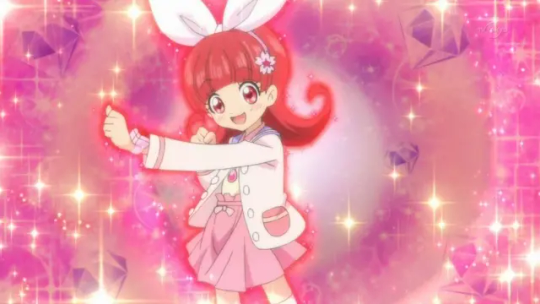
#jewelpet lillian#lady jewelpet#horror#psychological horror#techno horror#cyberpunk#anniversary project#romance#serial experiments lain#homage#serial experiments lain homage#jewelpethorror
9 notes
·
View notes